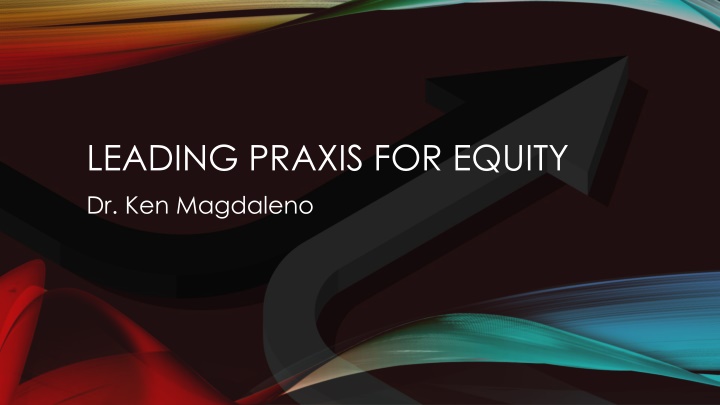
Addressing Social Justice Issues in Educational Leadership
Explore the impact of race, culture, gender, and socioeconomic factors on educational practice and leadership. Learn how leadership can contribute to creating a more equitable society by addressing social injustices. Discover strategies for fostering a more inclusive and diverse educational environment that advocates for marginalized communities.
Download Presentation

Please find below an Image/Link to download the presentation.
The content on the website is provided AS IS for your information and personal use only. It may not be sold, licensed, or shared on other websites without obtaining consent from the author. If you encounter any issues during the download, it is possible that the publisher has removed the file from their server.
You are allowed to download the files provided on this website for personal or commercial use, subject to the condition that they are used lawfully. All files are the property of their respective owners.
The content on the website is provided AS IS for your information and personal use only. It may not be sold, licensed, or shared on other websites without obtaining consent from the author.
E N D
Presentation Transcript
LEADING PRAXIS FOR EQUITY Dr. Ken Magdaleno
How do race, culture, gender, and socioeconomic levels impact your practice? KEY QUESTIONS How do race, culture, TO gender, and socioeconomic CONSIDER: levels impact student learning?
JAMES BALDWIN Not everything that is faced can be changed, but nothing can be changed until it is faced
AGENDA Social Justice Leadership Race (TED Talk, Discussion groups) Structural Racism (TED Talk, Discussion groups BREAK Ethno-racism (TED Talk, Discussion Groups) Colorblindness Praxis: Now What?
Leadership can play a critical role in either contributing to racial justice or reinforcing prevailing patterns of racial inequality and exclusion In an ever-changing multicultural society, filled LEADERSHIP with racial complexities, the role that leadership plays requires continual re- examination and reshaping to contribute in positive ways toward creating a society in which opportunities and benefits are more equally shared.
investigates and poses solutions for issues that generate and reproduce social inequities LEADERSHIP FOR SOCIAL JUSTICE Foster leadership must be critically educative; it can not only look at the conditions in which we live, but it also must decide how to change them
A majority of educational leaders have little knowledge or SOCIAL experience on how to address JUSTICE AND EDUCATIONAL LEADERSHIP issues of social justice which include race, culture, equity, gender, socioeconomic status, disability, power, and privilege
SOCIAL JUSTICE LEADERS MUST advocate, lead, and keep at the center of their practice and vision issues of race, class, gender, disability, sexual orientation, and other historically and currently marginalizing conditions in the United States (Theoharis, 2007, p.222). counter the sorting mechanism of schools (Villegas, 2007, p.378) and treat diverse students, families and communities fairly and equitably by being responsive to their needs and not just those of the dominant group (Villegas, 2007, p.371)
Race and Whiteness Race THE LIE THAT INVENTED RACISM Structural and Systemic Racism Praxis https://www.ted.com/talks/john_biewen_the _lie_that_invented_racism
Race is a social and political construct, not biological For most social scientists, race is distinct from ethnicity . A major distinction is the assumption of a RACE biological basis in the case of race. Races are distinguished by perceived common physical characteristics, which are thought to be fixed,
RACE Whereas ethnicities are defined by perceived common ancestry, history, and cultural practices, seen as more fluid and self-asserted rather than assigned by others Racism is an ideology of racial domination and a presumed hierarchal superiority over other racial groups to prescribe traits of inferiority
RACISM Racism is different from racial prejudice, hatred, or discrimination. Racism involves one group having the power to carry out systematic discrimination through the institutional policies and practices of the society and by shaping the cultural beliefs and values that support those racist policies and practices.
CORNELL WEST Race Matters...we need leaders who can situate themselves within a larger historical narrative of this country and our world, who can imagine a future ground in the best of our past, yet are attuned to the frightening obstacles that perplex us...
"STRUCTURAL RACISM" "Structural racism is the silent opportunity killer. It is the blind interaction between institutions, policies and practices which inevitably perpetuates barriers to opportunities and racial disparities." Maya Wiley, Center for Social Inclusion
STRUCTURAL RACISM Indicators/Manifestations: The key indicators of structural racism are inequalities in power, access, opportunities, treatment, and policy impacts and outcomes, whether they are intentional or not. Structural racism is more difficult to locate in a particular institution because it involves the reinforcing effects of multiple institutions and cultural norms, past and present, continually producing new, and re-producing old forms of racism (the way we ve always done it)
A system in which public policies, institutional practices, cultural representations, and other norms work in various, often reinforcing ways to perpetuate racial group inequity. It identifies dimensions of our culture and history that STRUCTURAL RACISM have allowed privileges associated with "whiteness" and disadvantages associated with "color" to endure and adapt over time. Structural racism is not something that a few people or institutions choose to practice. Instead it has been a feature of the social, economic and political systems in which we all exist. (Aspen Institute)
SYSTEMIC RACISM Racist beliefs/practices built into the foundation of a society that influences laws, institution and policies that keep racism in the system
ETHNO-RACISM Definition: racism perpetuated against an ethnic group Findings suggest that within the current climate of colorblind racism, ethno-racism is the mechanism through which the current racial order will be maintained However, in U.S. society, the dominant racial discourse is often based on the dichotomy of Black versus White; as such, much of the literature has been framed within this two-tiered conceptual approach
ETHNO-RACISM Ethnicity is fluid and self-determined but deals with common ancestry and cultural practices. Yet the Black-White binary racial discourse implicitly reifies the subordination of non- Black racial others by rendering them invisible in discussions and research on racism sandwiched in between Black and White racial constructions
LATINOS SANDWICHED Do Latinos suffer for reasons of culture and nationality, but not for their race ? . . . If we look at social conditions, at the actual experience of Latinos in the U.S., it makes more sense to conclude that the presence of national minority oppression doesn t signify the absence of racial oppression. . . . Social conditions affirm that combination of national, cultural, and racial oppression. . . . In a land where the national identity is white, nationality and race become interchangeable. We live today with a white definition of citizenship, which generates a racist dynamic. Marti nez (1998, pp. 474-475)
ETHNO-RACISM AND CHILDHOOD TRAUMA One in four children in classrooms nationwide has been exposed to some form of childhood trauma, and children who live below the poverty level are more likely to experience three or more adverse childhood experiences. 1 1 Downs, B., & Manning, J. B., Understanding How Trauma Affects Students. Scholastic (n.d.). Retrieved June 17, 2020, from http://www.scholastic.com/teachers/articles/18-19/understanding-how- trauma-affects-students/; Adverse Childhood Experiences. Child Trends (2019). Retrieved June 17, 2020, from https://www.childtrends.org/indicators/adverse-experiences.
Symptoms resulting from trauma can directly impact a student's ability to ETHNO- RACISM AND TRAUMA learn. Students might be distracted by intrusive thoughts about the event that prevent them from paying attention in class, studying, or doing well on a test. ... Some students might avoid going to school altogether.
SEVEN (7) REASONS WHY COLORBLINDNESS CONTRIBUTES TO RACISM INSTEAD OF SOLVING IT Colorblindness invalidates people s identities = Race is intimately tied to people s identities and signifies culture, tradition and language Colorblindness invalidates racist experiences such experiences must be validated and thoroughly addressed Colorblindness narrows White Americans understanding of the world and leads to disconnection
Colorblindness equates color with SEVEN (7) REASONS something negative WHY Colorblindness hinders tracking COLORBLINDNESS racial disparities CONTRIBUTES TO Colorblindness is disingenuous RACISM INSTEAD Colorblindness ideology is a form OF SOLVING IT of racism
PRAXIS Paulo Freire defines praxis in Pedagogy of the Oppressed as "reflection and action directed at the structures to be transformed." Through praxis, oppressed people can acquire a critical awareness of their own condition, and, with teacher-students and students- teachers, struggle for liberation. The Center for Leadership, Equity and Research (CLEAR) uses this definition to insist that we be action-oriented
Final thought for The only thing harder than today starting something new is As we address issues of Race, structural racism and Ethno-Racism stopping something old - Russell Ackoff - Redesigning Society


